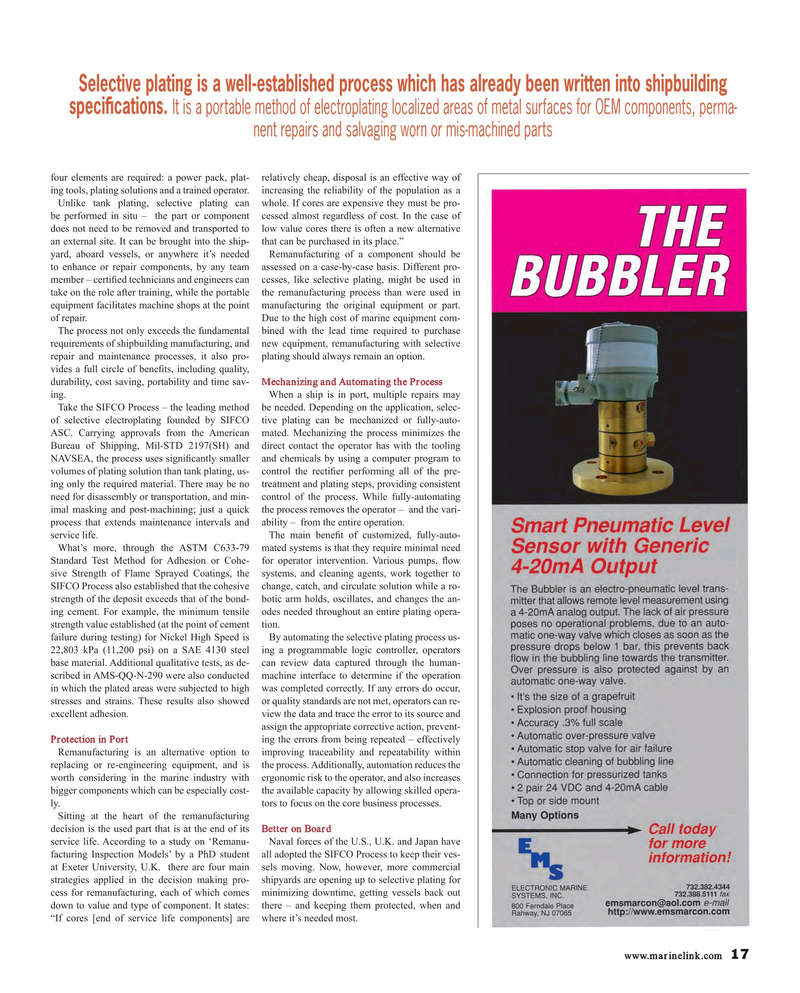
Page 17: of Maritime Reporter Magazine (September 2018)
Maritime Port & Ship Security
Read this page in Pdf, Flash or Html5 edition of September 2018 Maritime Reporter Magazine
Selective plating is a well-established process which has already been written into shipbuilding
It is a portable method of electroplating localized areas of metal surfaces for OEM components, perma- speci? cations. nent repairs and salvaging worn or mis-machined parts four elements are required: a power pack, plat- relatively cheap, disposal is an effective way of ing tools, plating solutions and a trained operator. increasing the reliability of the population as a
Unlike tank plating, selective plating can whole. If cores are expensive they must be pro- be performed in situ – the part or component cessed almost regardless of cost. In the case of does not need to be removed and transported to low value cores there is often a new alternative an external site. It can be brought into the ship- that can be purchased in its place.” yard, aboard vessels, or anywhere it’s needed Remanufacturing of a component should be to enhance or repair components, by any team assessed on a case-by-case basis. Different pro- member – certi? ed technicians and engineers can cesses, like selective plating, might be used in take on the role after training, while the portable the remanufacturing process than were used in equipment facilitates machine shops at the point manufacturing the original equipment or part. of repair. Due to the high cost of marine equipment com-
The process not only exceeds the fundamental bined with the lead time required to purchase requirements of shipbuilding manufacturing, and new equipment, remanufacturing with selective repair and maintenance processes, it also pro- plating should always remain an option.
vides a full circle of bene? ts, including quality, durability, cost saving, portability and time sav- Mechanizing and Automating the Process ing. When a ship is in port, multiple repairs may
Take the SIFCO Process – the leading method be needed. Depending on the application, selec- of selective electroplating founded by SIFCO tive plating can be mechanized or fully-auto-
ASC. Carrying approvals from the American mated. Mechanizing the process minimizes the
Bureau of Shipping, Mil-STD 2197(SH) and direct contact the operator has with the tooling
NAVSEA, the process uses signi? cantly smaller and chemicals by using a computer program to volumes of plating solution than tank plating, us- control the recti? er performing all of the pre- ing only the required material. There may be no treatment and plating steps, providing consistent need for disassembly or transportation, and min- control of the process. While fully-automating imal masking and post-machining; just a quick the process removes the operator – and the vari- process that extends maintenance intervals and ability – from the entire operation.
service life. The main bene? t of customized, fully-auto-
What’s more, through the ASTM C633-79 mated systems is that they require minimal need
Standard Test Method for Adhesion or Cohe- for operator intervention. Various pumps, ? ow sive Strength of Flame Sprayed Coatings, the systems, and cleaning agents, work together to
SIFCO Process also established that the cohesive change, catch, and circulate solution while a ro- strength of the deposit exceeds that of the bond- botic arm holds, oscillates, and changes the an- ing cement. For example, the minimum tensile odes needed throughout an entire plating opera- strength value established (at the point of cement tion. failure during testing) for Nickel High Speed is By automating the selective plating process us- 22,803 kPa (11,200 psi) on a SAE 4130 steel ing a programmable logic controller, operators base material. Additional qualitative tests, as de- can review data captured through the human- scribed in AMS-QQ-N-290 were also conducted machine interface to determine if the operation in which the plated areas were subjected to high was completed correctly. If any errors do occur, stresses and strains. These results also showed or quality standards are not met, operators can re- excellent adhesion. view the data and trace the error to its source and assign the appropriate corrective action, prevent-
Protection in Port ing the errors from being repeated – effectively
Remanufacturing is an alternative option to improving traceability and repeatability within replacing or re-engineering equipment, and is the process. Additionally, automation reduces the worth considering in the marine industry with ergonomic risk to the operator, and also increases bigger components which can be especially cost- the available capacity by allowing skilled opera- ly. tors to focus on the core business processes.
Sitting at the heart of the remanufacturing decision is the used part that is at the end of its Better on Board service life. According to a study on ‘Remanu- Naval forces of the U.S., U.K. and Japan have facturing Inspection Models’ by a PhD student all adopted the SIFCO Process to keep their ves- at Exeter University, U.K. there are four main sels moving. Now, however, more commercial strategies applied in the decision making pro- shipyards are opening up to selective plating for cess for remanufacturing, each of which comes minimizing downtime, getting vessels back out down to value and type of component. It states: there – and keeping them protected, when and “If cores [end of service life components] are where it’s needed most.
www.marinelink.com 17
MR #9 (10-17).indd 17 MR #9 (10-17).indd 17 9/5/2018 11:16:29 AM9/5/2018 11:16:29 AM

 16
16

 18
18
